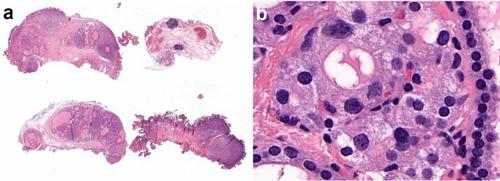Endocrine Pathology ( IF 4.4 ) Pub Date : 2023-02-01 , DOI: 10.1007/s12022-023-09749-1 Christopher M Sande 1 , Isabella Tondi Resta 1 , Virginia A Livolsi 1

|
The effects of many pharmacological agents on thyroid function are well known. Direct influences on measurements of thyroid function tests are also described. However, certain classes of drugs produce morphological changes in the gland. This review focuses on the significance of the following drug classes for the thyroid pathologist: iodine, antithyroid drugs, psychotropic drugs, antibiotics, cardiotropic drugs, antidiabetic drugs, and immunomodulatory agents. Radioactive iodine initially induces mild histologic changes; however, the long-term effects include marked follicular atrophy, fibrosis, and nuclear atypia—changes that vary depending on the pre-therapy condition of the gland. Some psychotropic drugs have been associated with a spectrum of inflammatory changes throughout the gland. The tetracycline class of antibiotics, namely minocycline, can lead to a grossly black thyroid gland with pigment seen in both colloid and follicular epithelial cells while variably present within thyroid nodules. The surgical pathologist most commonly sees an amiodarone-affected gland removed for hyperthyroidism, and the histologic findings again depend on the pre-therapy condition of the gland. While GLP-1 receptor agonists carry an FDA black box warning for patients with a personal or family history of multiple endocrine neoplasia or medullary thyroid carcinoma, the C cell hyperplasia originally noted in rats has not borne out in human studies. Finally, thyroiditis and hypothyroidism are well known complications of checkpoint inhibitor therapy, and rare cases of severe thyroiditis requiring urgent thyroidectomy have been reported with unique histologic findings. In this review, we describe the histologic findings for these drugs and more, in many cases including their functional consequences.
中文翻译:

甲状腺病理学家遇上治疗药理学
许多药物对甲状腺功能的影响是众所周知的。还描述了对甲状腺功能测试测量的直接影响。然而,某些类别的药物会在腺体中产生形态学变化。本综述重点关注以下药物类别对甲状腺病理学家的重要性:碘、抗甲状腺药物、精神药物、抗生素、强心药物、抗糖尿病药物和免疫调节剂。放射性碘最初会引起轻微的组织学变化;然而,长期影响包括明显的滤泡萎缩、纤维化和核异型——这些变化因腺体治疗前的状况而异。一些精神药物与整个腺体的一系列炎症变化有关。四环素类抗生素,即米诺环素,可导致明显黑色的甲状腺,在胶体和滤泡上皮细胞中均可见色素,同时在甲状腺结节内有不同程度的存在。外科病理学家最常看到因甲状腺功能亢进而切除受胺碘酮影响的腺体,而组织学检查结果再次取决于腺体的治疗前状况。虽然 GLP-1 受体激动剂对具有多发性内分泌瘤或甲状腺髓样癌个人或家族史的患者发出 FDA 黑框警告,但最初在大鼠中发现的 C 细胞增生并未在人体研究中得到证实。最后,甲状腺炎和甲状腺功能减退症是检查点抑制剂治疗的众所周知的并发症,并且已经报道了需要紧急甲状腺切除术的严重甲状腺炎的罕见病例,这些病例具有独特的组织学发现。在这篇评论中,



























 京公网安备 11010802027423号
京公网安备 11010802027423号